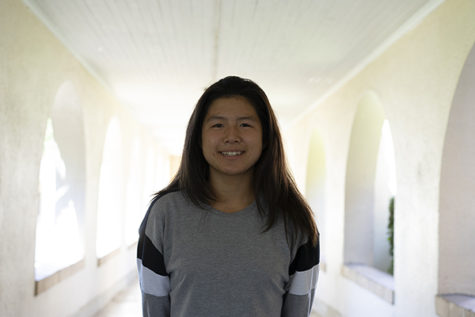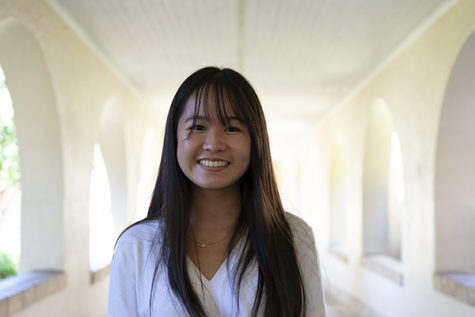Arts + Science
C Magazine explores the unlikely intertwining of two opposing subjects — art and science — and the importance of incorporating this new duo into society.
Art by Charlotte Amsbaugh and Leon Lau
The analytical, intensely detailed world of science and the creative, freeing world of art are commonly perceived to exist in disparate realms. Though these broad areas of study appear to be polar opposites, their intersection yields innovation and advancement in both the art and STEM (Science, Technology, Engineering and Math) fields. The collaboration between art and science is evident in many different elements, ranging from the materials used, to visual products, advancements in technology and more. As time has progressed, it has become clear that without elements of art in science and science in art, the advancement of both become limited. Integrating art and science throughout society, starting in education programs like STEAM (Science, Technology, Engineering, Arts and Math), has begun to expand people’s mindsets and will broaden the future opportunities for young people. This combination will not only advance each individual field, but will lead to massive changes and improvements within society itself.
Background
From the scientific revolution of the 14th century to the mass media age of today, art and science have worked cohesively to revolutionize the way in which we perceive the world. The drastic changes in the art and science fields during the Renaissance, extending from the 14th to 17th century, allowed artists like Leonardo Da Vinci to push for a deeper understanding of their surroundings. A primary example of the cohesion of art and science in Da Vinci’s work is his use of human anatomy to create life-like works of art. During the Renaissance period, spanning across three centuries, radical changes within the art world took place, such as the use of linear perspective and chiaroscuro to advance shading. Despite the advancements that arose, there were persistent societal restrictions on any free thought that went against the strict religious dogmas of the 15th century.
Later, the Enlightenment Era allowed scientific fields to flourish; coinciding with this prosperity, millions began to question the world they lived in and the purpose of their actions, resulting in a rapid progression of art and artistic techniques. Paul DeMarinis, a Stanford Art Practice professor and artist, comments on the fundamental need for both subjects, saying, “Art and early science both provided ways of coping … with [the] changes imposed by external events.”
The transition from a feeling of predictability to an overwhelming sense of confusion resulted in a complete shift in the art world; thus, a time of reasoning and introspection called the Baroque period was born. DeMarinis believes that the use of cultural practices to cope with an ever-changing world is one of the fundamental aspects of art throughout history. “The traditional roles of all these cultural practices, including art was, for many hundreds of millennia, to maintain a kind of predictable and steady orientation within a world full of unpredictable events,” DeMarinis said.
Revolutionary scientific discoveries of the Enlightenment fascinated populations and artists who used their artworks to capture this extreme enchantment in the eyes of millions. Whenever science progresses, it alters the way people perceive their surroundings, permitting art to step in and aid a population’s understanding and acceptance concerning the changes in their lives.
Technology
Technology and artwork are often viewed as separate entities, but technology can be incorporated into artwork to enhance a piece, allowing the artist to express a wider variety of ideas and emotions through their work. Aspects of technology can be utilized and applied to art in ways that add a practical function to a piece in order to fulfill and convey an artist’s intended message.
Technology can provoke diverse thoughts and provide a unique view on different topics, allowing people to find beauty in fields traditionally considered strictly technical and not creative.
“People under 30 know how to pay attention to electronic media while many do not know how to sit through a concert of music or look at paintings for very long,” DeMarinis said.
While traditional art may seem mundane to younger generations, the addition of tech grabs their attention due to its familiarity, creating a connection between the viewer and the piece.
While technological aspects help engage younger audiences, some believe using tech decreases the value of a piece, as it does not conform to the standards of traditional art. “Authenticity no longer depends on the aura,” DeMarinis said. “Rather, [it depends on] the cult of the artist.”
When creating a piece, the artist is the one who chooses the message they want to convey to their audience, whether it be social reform or personal thoughts. The way in which an artist utilizes technology and the level of artistry within the piece can directly affect the viewer’s perception of it.
The amount of tech used is not necessarily what is important, but rather how it is utilized and how it benefits the piece.
Some also believe the genuinity of art correlates to the amount of effort put in. Modern technology can now create paintings and songs with little to no effort required from the creator. “‘It is too easy’ – machine learning (e.g. WaveNet) can compose a classical piano sonata in a wink,” DeMarinis said.
There is a worry that technology provides a shortcut to a beautiful end product. Technology used in art without thought or skill can be degrading, but when applied intentionally to convey a message, it is an effective and enhancing addition to a variety of pieces.
Artist Peter Wegner created the piece “Monument to Change as it Changes,” displayed by Stanford’s Graduate School of Business, spanning a wall with steel and polycarbonate. The structure displays 2,048 flaps of different colors, each programmed to flip into various patterns. These designs change, and each can remain unique and unrepeated for a duration of eight hours. The technology behind this piece comes from European train stations where flaps similar to these are used to display train arrival and departure times. These changing train station times are displayed on rotating flaps which had inspired Wegner’s work. This installation is a representation of the constantly evolving future. Especially in the world of business and finance, the future of industries are always adapting. These shifting patterns mimic reality and symbolize the movement of the world since it never remains stationary.
Wegner’s art piece has given colorful emotion to the technical world of business and finance. It exposes a different, softer side of industries, altering the way people think of these numerical and highly structured fields and the reality of an evolving future. The use of technology allowed Wegner to convey his message and show change in a way that fully embodies the versatility of communities, people and of the world around us.
Materials and Ceramics
Artwork can benefit from the utilization of scientific techniques through the analysis of the material components of a piece. In the field of material science, the design and discovery of substances are combined with an understanding of physics, chemistry and engineering. By inspecting art mediums through a scientific lens, scientists and artists can work together to determine the best elements for a particular piece, in order to elevate its quality and longevity.
To combine these focuses, Stanford University chemical engineering professor Curt Frank and Stanford art teacher Sara Loesch-Frank teach a class called An Exploration of Art Materials: The Intersection of Art and Science, where students study art materials in a scientific context. Frank and Loesch-Frank created an environment where painters, sculptors and photographers interact with chemists, anthropologists, and bioengineers to enrich their understandings of the scientific and artistic aspects of art materials.
“Artists and scientists both enjoy experimenting so it is odd that they have been thought of as opposites over the years,” Frank and Loesch-Frank wrote in their paper, Perspectives on Art Materials. “Through trying different approaches, both fields benefit, so this pairing seems appropriate.”
Analysis of the composition of art provides an in-depth view of the materials that were relevant to the time period it was originally created in. This application of material science exposes the cultural context of the artwork. By examining the properties of various pieces, scientists and artists can make claims about art during varying times in history. “Getting to see beneath the surfaces of Old Masters [paintings made before 1800] from all over the world, with the aid of scientific techniques, is similar to having a conversation with the artists of various cultures and times,” Frank and Loesch-Frank wrote.
The progressive interactions between science and art not only provide insight into the history and culture surrounding past works of art, but also contribute to the quality and longevity of the artwork for the present, as well as the future. Some materials do not retain the same properties in certain conditions and can negatively affect the longevity of pieces.
Health issues are also associated with the use of various materials, as many artists have suffered from symptoms as a result of prolonged exposure to toxic compounds. Through creating an interdisciplinary study of material science and art composition, Frank and Loesch-Frank contribute to the art community by educating students about the importance of understanding the health effects of certain techniques and components in art. “Often other processes can change how the materials behave and sometimes can have dire consequences to the artist, the artwork being created or the ability of the artwork to stand the test of time,” Frank and Loesch-Frank wrote. “Conservation and preservation of art are aspects that need scientific backgrounds and can help us better understand the culture in which they were made.”
Ceramics, in particular, is a highly technical form of art that gains a great deal from material science studies. Though many master sculptors manage to develop the intuition to determine the best molding, firing and glazing techniques through years of hands-on experience, it is useful for sculptors to connect these artistic techniques to broader topics of physics and chemistry. Ceramicists perfect their craft by understanding how to manipulate heat and pressure by applying scientific concepts to different techniques.
Hideo Mabuchi, a professional physicist and the Department Chair of Applied Physics at Stanford University, investigates ceramics and ancient craft practices through the lens of applied physics by using state-of-the-art microscope equipment. “As an artist working with clay, there are many ways to achieve beautiful fired surfaces using traditional firing techniques if you understand how best to tailor your clay body composition and the details of your firing process,” Mabuchi said. “Being a professional scientist myself, however, I believe that there is a lot to be gained by making those connections [to broader scientific ideas] whenever you can.”
Mabuchi teaches an applied physics class called The Questions of Clay: Craft, Creativity and Scientific Process, where students learn about the technical aspects of ceramics.
This class encourages students to use their experience of applied physics in a creative manner that is less theoretical and more tangible. “I find that the real unifying theme of the class is creative process,” Mabuchi said. “Students need to develop a sense of creative process in order to make ceramic artwork that is expressive and individualistic. At the same time, I try to help them realize that scientific research relies upon a kind of creative process that can be very similar to what they pursue in the studio.”The intersection of these seemingly unrelated fields yields many results that provide insight into the cause of many natural phenomena. By combining applied physics and ceramics as an interdisciplinary study, Mabuchi has found that the connections between the two subject areas can be used to advance both technology and art. “It is possible that further research on these unexpected connections could yield new clues for improving high-tech approaches to synthesizing these kinds of crystal formations,” Mabuchi said. “At the same time, I think that knowing about these connections makes the traditional wood-fired ceramic surfaces more profound and, in a sense, more beautiful.”Thanks to the various explorations of the art and science intersection, advances and discoveries have been made that can benefit the world in many ways. Whether it is developing a better technique to preserve an art piece, researching the health risks associated with different art materials or studying the physical concepts of wood-firing ceramic surfaces, the undeniable connections between science and art are paving the way for a growing interdisciplinary field.
Visual
Visual art can be found in many different forms, ranging from photography to drawing and filmmaking to architecture. However, science, unrecognized by most, plays a large role in creating these pieces, making them more appealing, innovative and marketable to a wider audience. There
are many different ways that art and science can be combined; one example is when artists and scientists collaborate to create a cohesive, innovative piece.
When integrating science and visual arts, there are many elements to consider, such as color, lighting, angles and creativity, all of which are combined to produce an original piece. Science and visual art have been present throughout history as shown by individuals such as Albert Einstein, Leonardo Da Vinci, Galileo and many other notable names who worked to create scientific and artistic change, giving a platform to the development seen today.
Jeannette Murray, an art adviser to the American Association for the Advancement of Science (AAAS) in Washington, DC, researched some of the first cave paintings. These paintings date back to the European Ice Age, depicting animals, weapons and other hunting images that were “perhaps the first instance of the interweaving of art and science.” However, visual arts began making significant advancements in the 19th century, with inventions such as the camera and television, showing that this combination still has more to offer throughout the advancements of society. As this field progresses, it continues to gain more attention and is more commonly seen in media, schools and society in general.
“The use of images to explain the invisible in science is [an] everyday example,” De Marinis said. One example of merging images and science to create an educational yet beautiful piece is an exhibit called “Plasticity: Our Changing Oceans” by JD Whitman, a Master of Fine Arts (MFA) candidate at the University of Iowa. Whitman studied marine biology during her Stanley Fellowship in Ireland, while working with the local Natural History Museum. In her collaboration with the museum, Whitman created a piece that “‘is a hybrid between art and marine ecology,”’ she explains in an interview featured in The Gazette.
Whitman’s piece is a simulation of an underwater world, with magical drawings of sea life projecting on the inflated walls made of discarded plastic that Whitman has collected over the course of two years. Whitman’s intent with this piece is to educate the public on the beauty and importance of the ocean, as well as the impact that plastic pollution has on it and its organisms. “Plasticity: Our Changing Oceans” is just one of many examples of how art and science are combined to benefit and impact society. As this approach of combining these two subjects to create a product continues to spread, both artists and scientists are beginning to envision more creative ways to expand their own fields, marveling at the beauty of intertwining two subjects that are thought to be opposite by most.
Education
The concept of mixing art and science has also made its way into the education system. Up until recently, students either specialized in STEM or liberal arts. Statistically speaking, individuals who study STEM go into higher wage professions and, therefore, are often given more attention, resulting in a lack of focus on art programs in schools. In order to truly give students a well-rounded education, schools ranging from elementary to college are attempting to integrate art and science into their curriculums. Many individuals who lack an emphasis of arts in their education are less qualified for a multitude of jobs and have less flexibility while exploring different careers. Having a creative mindset is essential in all types of professions, but is not achievable if school subjects are strictly segregated.
The integration of art and science within schools is starting to be implemented at preschool levels and is expanding all the way to some of the most prestigious colleges. One example of advancing open-minded thinking is the STEAM initiative. This competitive program began as a curriculum led by students at Rhode Island School of Design (RISD) is now being offered at elite schools such as Brown, MIT, Yale, Harvard and more. Based on the principles of STEM, the goal of STEAM is to create a program that covers all of the skills necessary in the 21st century. STEAM offers subclasses that specialize in certain fields such as BioSTEAM, which explores living things and their visual aesthetics, and CyberSTEAM, which looks into the ways computer science and technology can create art and understanding. Incorporating STEAM into schools is not an easy task, however, since it takes hard work and communication between teachers of various subjects to create collaborative lesson plans. Nonetheless, these programs that fuse art and science together are becoming significantly more popular as they expose students to the idea that it is okay to be interested in two seemingly opposite subjects, and possible to be successful in more than just one.
Art and science are inextricably linked in ways that many cannot begin to fathom. We live in a world where art is valued for its expression, and science is valued for its analytical attention to detail. There is not, however, any clear reason that the two subjects should be exist in such separate domains. Together, the two areas of study reveal deep connections in nature that both scientists and artists strive to emulate in their work, leaving infinite possibilities for the combined future of these two expanding fields. “Often, the initial attempts that people make tend to fall into one of two categories: art in the service of science… or science in the service of art,” Mabuchi said. “In my opinion, both of these sorts of ‘one-way’ approaches fall short of what should be our true goal. I think we should aspire to do work that is both art and science at the same time.”











